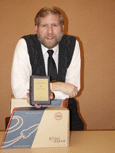http://www.forbes.com/sites/stevenbertoni/2013/09/05/oyster-launches-netflix-for-books/
So a start up called Oyster is working on a Netflix model for eBooks. A big deal or not?
Only time will tell of course, but in a world where convenience is king and ease of use trumps nearly everything else, the folks at Oyster may just be about to disrupt one of this biggest changes that have been rolling through libraries in a very long time, the eBook.
Some of my colleagues have looked at their as yet somewhat meager offerings and limited platform support, at the moment only Apple's iOS, not Android, and declared that they will continue to get their eBooks from other sources, including the good old public library. That's all well and good, but I fear they may be somewhat short sighted in their view of what library users want and are willing to put up with, just to get free content.
When Netflix started it served a niche market of movie
aficionados seeking titles that the big box video stores typically didn’t
carry. Remember those big stores pushed aside the local video club stores of a
decade earlier. Ultimately Netflix grew and grew until it finally pushed even
those big video stores out of business—think Blockbuster. Right now Oyster is
at that very beginning stage like Netflix was several years ago.
Avid library users consult a variety of sources such as Wowbrary, Novelist,
Goodreads, and LibraryThing seeking out good things to read. All of these point out the difficulty a busy reader faces. This
tidbit here, that waiting list there. Perhaps the reader can get that title free for the
Library, but will have to buy that one from Amazon, or BN.com, or Apple or
GooglePlay etc. Meijer and Wal-Mart grew to their current size, because
shoppers value their time and one stop shopping where they can get it all. Sure
the mall still probably provides more overall selection, but how often do you go
there vs. a single stop at the Mega-Mart?
To the average, dare I say uninformed consumer, the Library is
still about physical books. They don’t know, and don’t think to ask if we have
eBooks. Top that off with the restrictions placed on us by the publishers; the
hoops the users have to go through to get a free Library eBook, and so forth, it’s
just too difficult. Certainly it’s too hard for a consumer of a certain level
of available time and disposable income who will prefer ease of use and a wide
selection of the most popular titles, read that manufactured best sellers, not
necessarily available to the Library eBook market from the publisher.
I’ve argued long and hard to make the Library, The Digital
Filling Station. Bring us, virtually, your device and we’ll fill it up with
content, for FREE. We’ve achieved that goal to a degree, but now it seems we’re
only allowed to pump regular, not Ethyl because some of the publishers still refuse to
sell us Ethyl at any price, and some grossly overcharge us for mid-grade.
As is exists right now Oyster is a curious little experiment.
Given the outcome of the Apple eBook pricing trial, perhaps the DOJ will slap
them down and bar them from growing into a serious service, but I doubt it. The
subscription library model has served Netflix very well, and with the rise of
the all connected tablet, I see this as the next big thing in eReading, ease of
use without ownership. It sure seems to work for streaming video, and the
publishers sure seem to like it when you can’t “own” their stuff so they can
sell it again and again and again.
Just my thoughts, and why I think this is a big deal.
